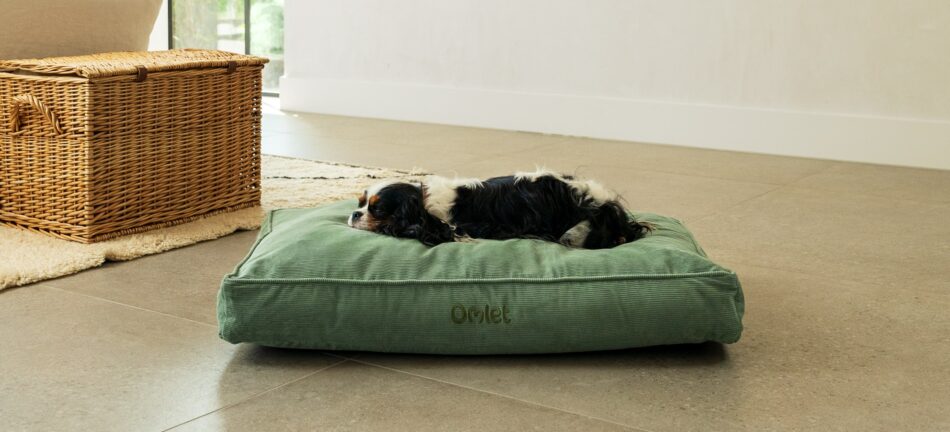
It’s easy to underestimate how much you’ll need to pack for a family holiday, especially if your four-legged friend is joining the adventure too. And just as you’ve finally jammed the boot of your car shut, you realise something is missing! Sound familiar? But what if that something is your dog’s bed? Big bulky beds aren’t easy to cram into a full car, but your pup’s prized possession is the last thing you want to leave behind. So, let’s find out what the best dog bed to travel with is for when you’re short on space.
Why do dogs need a bed to travel?
A change in environment can be overwhelming for dogs. For one, you might be joined by additional family members and friends on holiday, which means a change in routine. Not only do dogs then have to adjust to new sights and sounds, but their heightened sense of smell also means exploring somewhere new with their nose too. Having something such as a dog bed that smells familiar provides them with an element of comfort for when they’re staying away from home. In turn, this sense of familiarity will help make your trip away as enjoyable for them as it is for you.
Introducing Omlet’s Cushion dog bed. The ‘go-anywhere’ bed has been designed to travel from place to place with no fuss. The lightweight material means the mattress can simply be packed away in the car before heading out and placed down again when you reach your destination. But what else makes this the best dog bed to travel with?
Pillowy-soft sleep support
The Cushion dog bed may be made of lightweight materials, but we’d never compromise on comfort. We know that the perfect dog bed is key to a guaranteed good night’s sleep, especially for getting in those extra ZZZs after a long day of walkies on holiday. Filled with stuffing, the Cushion bed has been expertly crafted to balance pillowy-soft sleep support with just the right amount of plumpness to offer the perfect dog snoozing spot.
Beautifully designed prints
We knew that a dog bed that felt amazing wasn’t enough, which is why we created a range of designer covers to make our beds look amazing too. Choose from a selection of patterns, inspired by the beauty of nature to remind you of the outdoors when you step inside. The Morning Meadow and Gardenia Sage prints are perfect for going away on a doggy adventure, as a beautiful nod to nature. You can even find a matching dog collar and lead from our Dog Walk and Gardenia collections for your furry friend to look stylish on holiday and back home, too.
Dog-proof fabric
Chewing, digging, scratching and mouthing can be normal canine behaviours, but can also sometimes be elevated in stressful situations, such as travelling and being away from home for some dogs. Before heading on an adventure with your dog, though, you should assess whether they’re ready to do so, or if you need to work out an alternative.
This being said, unexpected situations can arise, which can equal stress and anxiety for you and your canine companion. We wanted to create a dog mattress that could withstand any of these behaviours and did so with the Cushion dog bed. Nearly all of our beds are made from 100% recycled bottles, making them super tough and rip-resistant from dog teeth and paws.
Easy cleaning for the messiest of pups
A few hiking adventures and beach walks later, your dog’s bed is bound to be covered in at least a few muddy pawprints. But throwing your dog’s bed away after every holiday isn’t the answer. Fortunately, the Cushion dog bed was made to last, with removable covers that can be zipped off and thrown into the washing machine to get rid of any dirt and odour.
Getting your dog used to their new bed
It’s a good idea to have your dog used to their bed before taking it on your travels. This will give them time to adjust to not only how the new bed feels, but how it smells as well. Regardless of how comfortable a new dog bed is, it can initially take time for Fido to get used to it. The scent of their existing bed might be super stinky to you, but this odour isn’t quite so foul-smelling to them. This means it can take some time for them to love their new mattress as much as you.
To get your dog used to their new bed, you’ll need to associate it with being a positive space. Use plenty of praise when they lie on their mattress, or if they’re more food-motivated, offer some tasty dog treats instead. You can even add a dog blanket on top so that your pup can be assured that they’ve got the cosiest spot in the house. For more advice on how to get your dog used to their new bed, read our previous blog.
Omlet and your dog’s travels
Make travelling with your dog as stress-free as possible and your holiday great fun with the help of Omlet dog products. Our Cushion dog bed is the perfect travel bed for you to use at home and away, and paired with a super soft dog blanket, your furry friend won’t be able to resist.
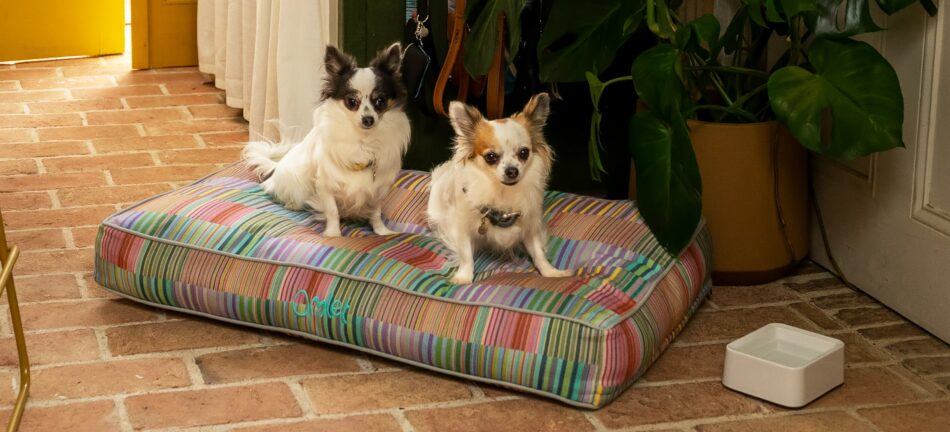

This entry was posted in Uncategorised
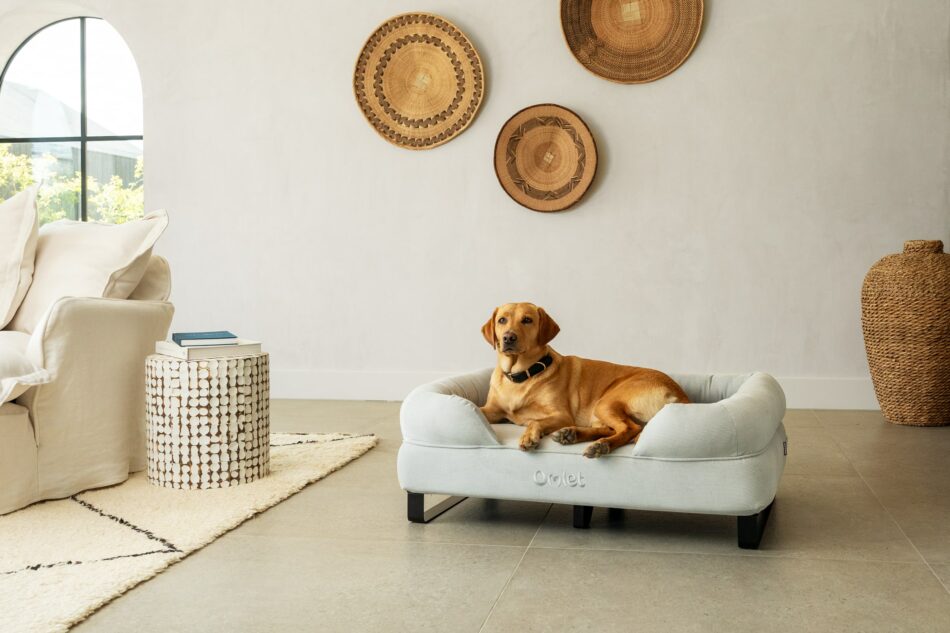
As the vibrant colours of autumn begin to paint the world outside, it’s only natural to want to extend the cosy ambience to your home interior. While you let the warmth of the new season take centre stage in your decor, don’t forget to upgrade your dog’s bed to suit your autumnal interiors. At Omlet, we found the best way to enhance your dog’s comfort and your home’s aesthetics is with the timeless comfort of corduroy. Discover your dog’s next and last bed to suit your autumn decor with our new Corduroy dog bed collection.
Pebbled perfection
Influenced by the flexing of dog paws on the smooth stones of a beach walk, the Omlet Corduroy Pebble dog beds were purposefully curated to embrace your dog’s feeling of comfort. The beautiful colour of this limited edition design creates a calm space for your dog within any space of your home. As the colder temperatures of autumn find their way into our lives, the Corduroy Pebble dog bed offers a swaddling cuddle for your favourite furry friend and a peaceful palette of beauty to your decor.
Matched in moss
The hues and tones of autumn can vary from state to state. But the colours of the first rays of sunlight as it beckons over your morning walk with your dog remain the same. And that was the inspiration behind the Omlet Corduroy Moss dog bed design. The subtle green shade reminds you of the morning dew sniffed in gratitude by your canine companion and reflects a soft and warm embrace in your interior. A timeless design with the tactile luxury of corduroy, the Moss dog bed will comfort your dog from mid-morning nap until post-walk bedtime.
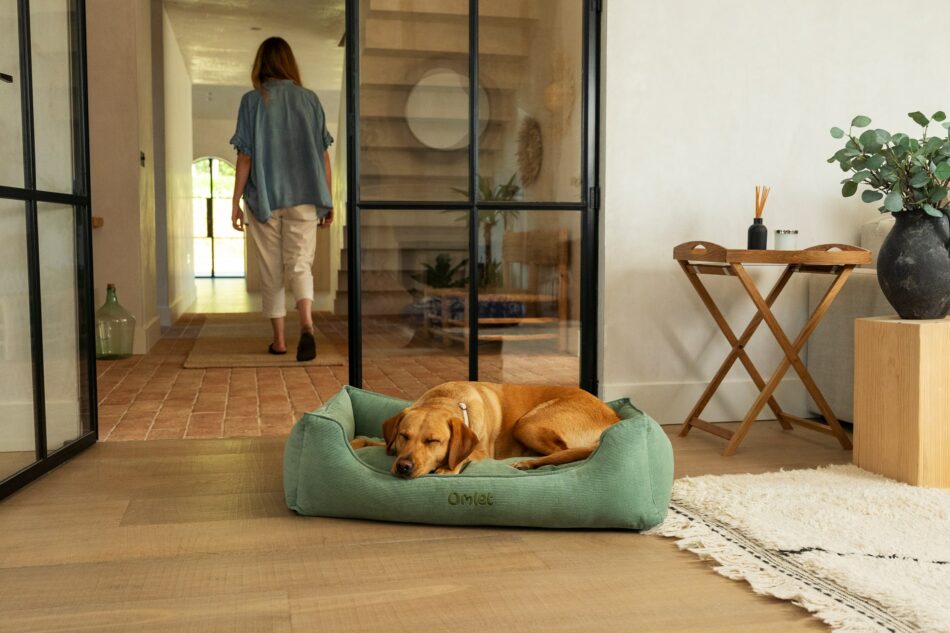
Pick a cover, pick a bed
Having a dog bed that looks good is one thing. But having one that comforts, supports and, more importantly, lasts is another. At Omlet, we believe both are equally important and essential to your dog’s care so we designed our products that way. The Corduroy Collection was inspired by the effortless connection between human and canine with colours and materials that reflect comfort and beauty.
Both corduroy covers can seamlessly be used on the Omlet Bolster dog bed, Nest dog bed, and Cushion dog beds. Designed with the same easy-to-clean and durable features, these luxurious fabrics are the perfect way to give your dog that fresh clean sheet feeling. Whether you’re changing up your interior style completely, or just washing muddy paw prints off another cover, the Corduroy Collection by Omlet is sure to add style to both your dog and your home.
Accessories to suit
Autumnal decor is all about creating a multi-layered and textured environment. Whether you choose the Pebble Corduroy or the Moss Corduroy, you’ll need accessories to match. As the temperatures outside begin to drop, chillier nights call for added comfort for your furry friend. In these early days of autumn, the Omlet Super Soft Dog Blanket is a great addition to give your dog more warmth and comfort in their slumber. And as you make your way further into the season when the temperatures really begin to plummet, use the Luxury Faux Sheepskin dog blanket that will not only add that extra needed layer of warmth, but will look great amongst all your autumn decor.
Autumn is also the gateway to the long, dark days of winter where feelings of hibernation sit on the horizon. Give your dog the gift of a more comfortable sleep as you move into this season with stylish dog bed feet that raise their comfort and happiness. The transition into autumn means more muddy walks in the forest amongst fallen, crunchy leaves. Which for you, means more time cleaning up messes. That’s why we created our exclusively designed dog bed feet for the Omlet Topology and Bolster dog beds to help improve airflow, prevent build-up of dirt and debris, and create a more healthy and hygienic environment.
Omlet and your dog
At Omlet, we’re pet people, and we bring our personal experience into every design solution we create. No matter what season you’re in, we make products that cater to the needs of your dog while ensuring they will always look good in your home. From super comfy dog beds that match your autumn decor to cosy dog blankets and stylish dog bed feet that add warmth to everyone’s surroundings, Omlet has designed the products that you and your dog can enjoy for the rest of the year ahead.


This entry was posted in Uncategorised
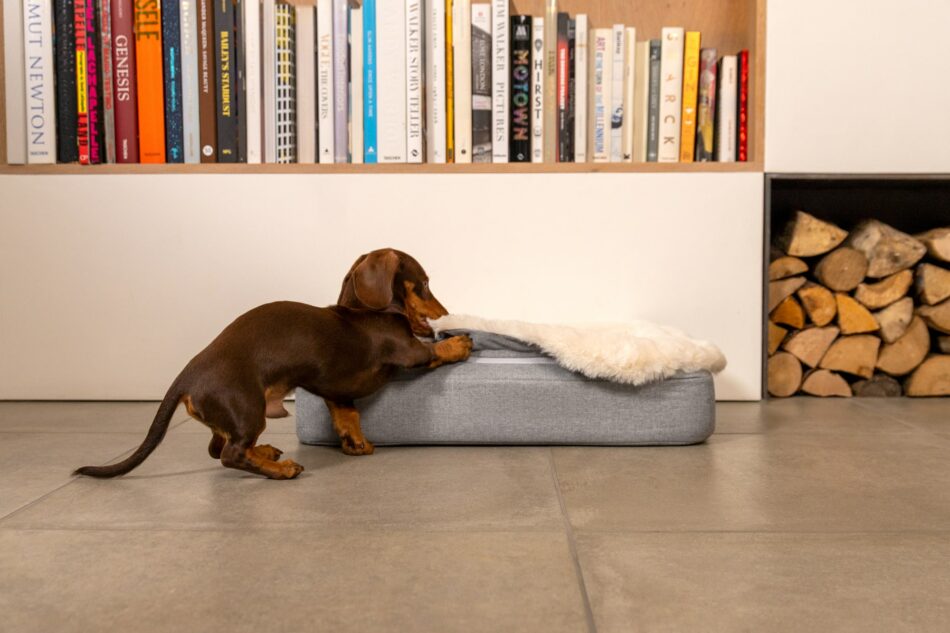
When it comes to your furry friends, we believe they deserve nothing but the best. This is why we created the Topology dog bed – a revolutionary pet bedding solution that has already changed the way pet parents care for their four-legged companion. The Topology dog bed isn’t just an ordinary dog bed – it’s a commitment to comfort and versatility that will last a lifetime. Crafted with precision and love, our unique interchangeable toppers allow you to tailor your dog’s sleeping experience to match the ever-changing weather and seasons. So as summer is fading into a new season, let us help you decide which Topology topper you should get for autumn.
How does the Topology dog bed work?
Quality and longevity are at the heart of our design philosophy with the Topology dog bed. Built to withstand the rigours of your dog’s life, our exclusive memory foam mattress base provides a supportive and dreamy sleep that moulds to your dog’s body and creates unparalleled comfort. But our designers went even further in perfecting the ultimate dog bed. In order to perfect comfort, we created a dog bed that would look great in homes as well by not compromising on style.
Say goodbye to constantly replacing your dog’s bed as the seasons shift. With the Topology dog bed, you can effortlessly switch between our wide range of topper options all year long to give your dog, and your home, that new fresh feel. Our range of toppers provides the perfect balance of comfort, temperature regulation, and durability, ensuring your pup stays content and relaxed year-round.
We also thought beyond the confines of the ordinary dog bed to create custom options that allow you to raise your dog’s comfort – literally. The exclusive Omlet dog bed feet are designed to bring new heights of style and relaxation to your dog’s sleep while simultaneously increasing airflow, eliminating dust build-up, and creating a healthier sleeping environment. The Topology dog bed is more than just a place for your dog to sleep – it’s a custom-created sleep environment that’ll always make them feel at home.
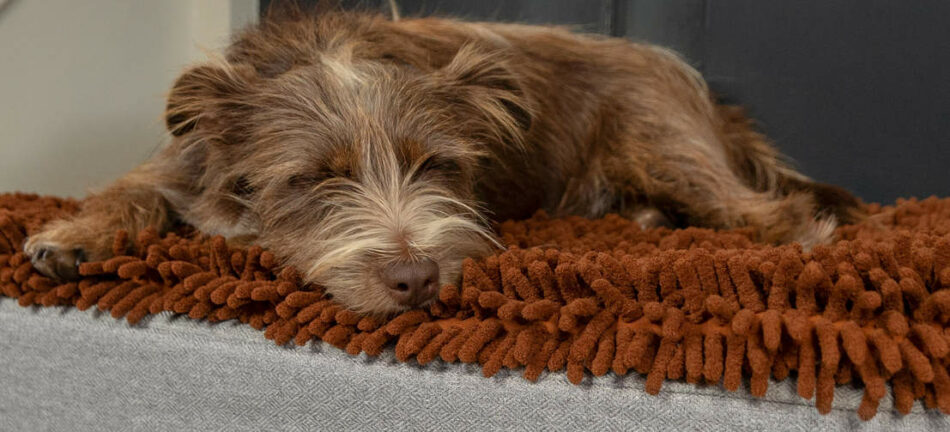
Which Topology topper is best for autumn?
As the leaves begin to change colours and the warm air turns cool, we welcome the changing of weather into autumn. But how do you make sure your dog feels the same comfort of this new season? The Topology dog bed is an autumn essential for any dog and choosing the right topper means considering their comfort, needs, and preferences that accompany this new weather.
Beanbag Topology topper
The Topology Beanbag topper is a plush, yet hard-wearing, topper that’s the perfect autumn companion for your dog as they start to spend more time indoors. Constructed with unparalleled comfort that mimics the softness and warmth of a bean bag chair, the Beanbag topper provides a nest-like feel that envelops your dog in a cocoon of cosiness. Opt for the crisp yellow shade, and this colour will add beauty and warmth to your interior autumn decor, making this the perfect choice for a new season and new dog bed topper.
Microfibre Topology topper
When autumn brings rain and dampness, your dog deserves a comfortable and dry place to rest. The Microfibre Topology topper is the perfect option with its fast-absorbing material that easily soaks up water and mud from damp fur and paws that accompany autumnal walks. There’s no more soggy bedding with this quick-drying topper, that keeps your dog will keep comfortable and ready to snuggle in no time. And just like every Topology dog bed topper, the Microfibre topper is easy to remove and toss in the washing machine for hassle-free dog bed cleaning and care.
Sheepskin Topology topper
The Sheepskin Topology topper is the ultimate choice to keep your dog cosy and comfortable this season with its luxurious softness and insulating warmth. Create a welcoming haven for your furry friend with this topper that allows them to curl up in a peaceful slumber. Beyond its functionality, the Sheepskin topper adds an element of sophistication to your dog’s domain. Choose from three different sizes and multiple shades to complement your home decor. For the autumn, we recommend soft beige or damson purple as two colours that perfectly reflect the feelings of the outside.
Autumn dog bed accessories
Creating the perfect autumnal retreat for your canine companion includes more than just a bed. At Omlet, we believe everything is better with accessories. So in an effort to elevate your dog’s comfort during the autumn season, consider adding a luxurious, soft dog blanket to their bed for increased layers of warmth and cosiness.
Want to give your dog a domain all their own this autumn? Place their dog bed and blanket inside a dog crate to create a safe space that will be their personal sanctuary for comfort and warmth all season long. The Omlet Fido Nook dog crate is the perfect option as it not only gives your dog a feeling of security, but adds style and beauty to your interior decor.
Omlet and your dog’s bed
This autumn, Omlet is your one-stop destination for ensuring your dog stays warm and comfortable throughout the changing of leaves and weather. Start your dog’s season off right with the Topology dog bed which is the heart of our collection. Next, choose a versatile Topology topper from our wide range of styles and colours to match your dog’s specific level of comfort and needs. Add a Luxury dog blanket to go on top and – voila – you just created the ultimate autumn-ready doggy comfort zone. All that’s left to do is enjoy the new season with your favourite pup.
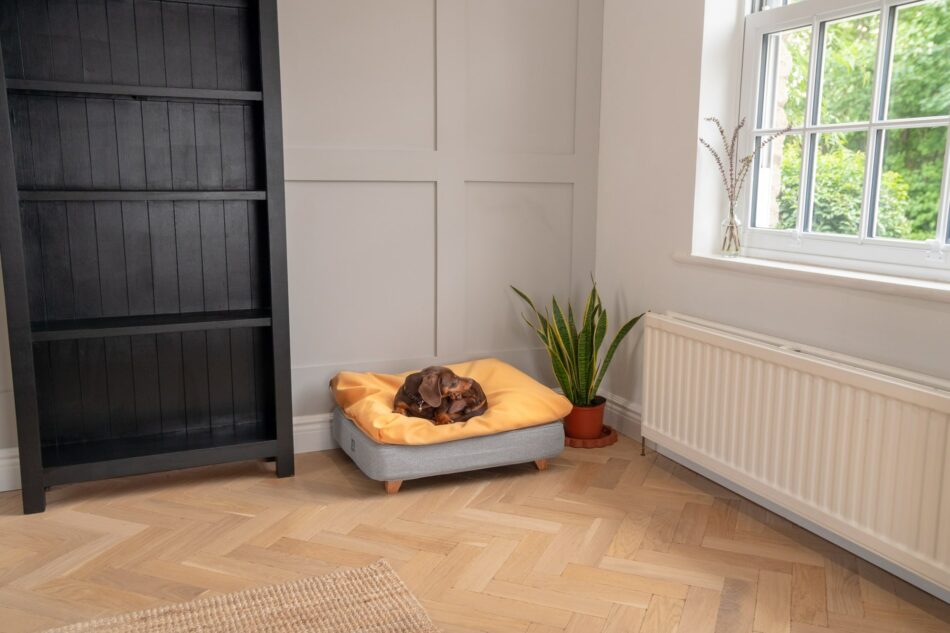

This entry was posted in Uncategorised
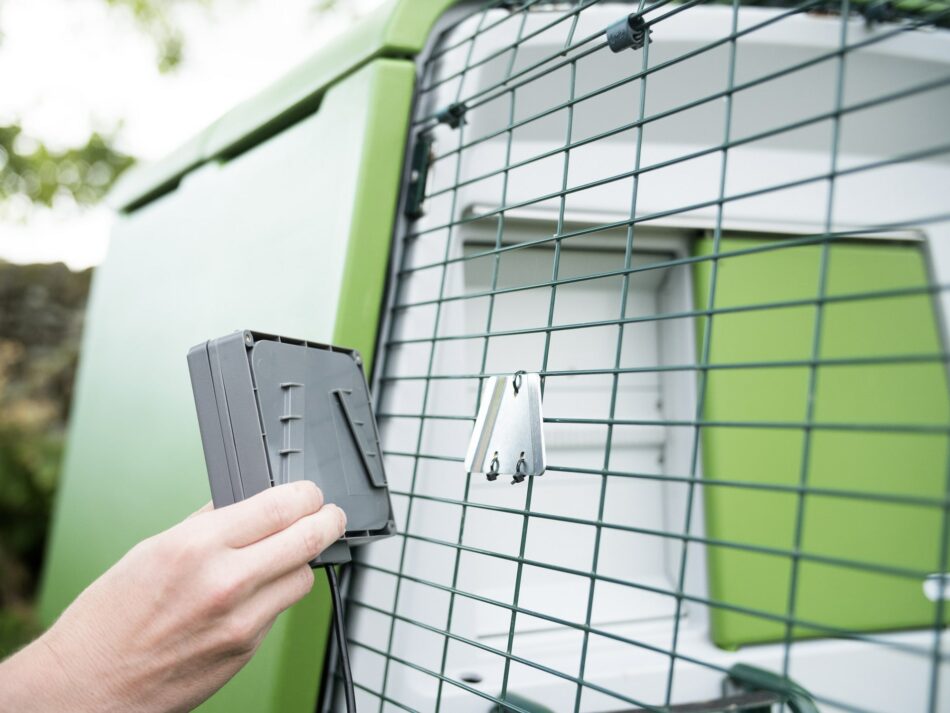
Have you considered reinforcing your flock’s setup and thought: are automatic chicken coop doors predator resistant? The short answer is yes, but not all automatic chicken coop doors are created equal. Adding an electronic door to your hens’ house can help prevent predator break-ins – if you choose the right one. We’ll highlight the distinctions between the types of automatic chicken coop doors, and why they make a difference in protecting your flock from unwanted visitors.
Why your chicken coop needs an automatic door
Automatic chicken coop doors offer an extra layer of security between your flock and the chicken predators that will try to break into their chicken coop. The doors can be programmed to close your flock in for the night, even while you’re away. In the morning, automatic chicken coop doors can let your hens out for you so that you don’t have to rise as early as your flock. Other benefits of an automatic chicken coop door include:
- Better chicken coop insulation
- Automation of your flock’s schedule
- Increased coop security to prevent accidental door openings
Technology has permeated the chicken-keeping world, making it more convenient than ever to care for your chickens. Automatic chicken coop doors are your first step in creating a smart chicken coop, allowing you more freedom and offering more security to your flock. But choosing the right automatic chicken coop door is important.
What makes an automatic chicken coop door predator resistant?
Automatic chicken coop doors are considered predator resistant because they have a motorized opening and closing method that make your chicken coop or chicken tractor more secure. Once closed, the gears that move the door hold it closed, making it more difficult to open from the outside. Good automatic chicken coop doors should create a seal once they’re closed, which also improves coop insulation.
Most automatic chicken coop doors open vertically. This poses two main issues:
- Vertically opening doors can be pried and pushed up by predators relatively easily. They use their paws and claws to create a gap along the bottom of the door, and are then able to push the door up and slip through.
- A coop door malfunction can cause the door to fall on one of your chickens, which can pin or seriously injure them.
Horizontally closing chicken coop doors are much safer for your hens. They’re harder for predators to pry open, and since they don’t rely on gravity or pulleys, won’t accidentally fall on your chickens.

Omlet’s predator-resistant Autodoor for hen houses
Omlet’s automatic chicken coop door (dubbed the “Autodoor”), was designed to give chicken keepers more freedom and peace of mind. The Autodoor tucks hens in for the night even when their owners aren’t home – ensuring they’re safe from predators that move in the cover of darkness.
The universal fit of the Autodoor allows it to be attached to any chicken coop or chicken run. This highly versatile design allows the Autodoor to be installed on virtually any setup. Install on an existing chicken wire run, wooden chicken coop, or on one of Omlet’s chicken runs by choosing from the appropriate installation kits. The Autodoor also integrates seamlessly with the Eglu Cube, without needing to remove the existing door.
The Autodoor is made from heavy-duty materials that are designed to last a lifetime, and opens on a horizontal coil mechanism. Once closed, the Autodoor keeps your hens safe inside their home from both predators and the elements.
Program the Autodoor with either a schedule based on light or a specific time. Most chicken predators are most active at dusk and shortly before dawn. The Autodoor can keep your chickens safely closed in their coop until the desired daylight or time has been reached.
Chicken predators and the Autodoor
All of our chicken runs have anti-dig skirting to help prevent predators from tunnelling in. And, the lower panels of the Eglu Cube’s attached run feature a tighter mesh to prevent predators from reaching through. Combined with the Autodoor, the Eglu Cube and its attached run is the best setup when creating a predator-resistant chicken coop, ensuring your hens stay as safe as possible from predators.
4 additional ways to protect your flock from predators
In addition to having a coop concierge to close your chickens in at night, you can take precautions to keep predators at bay. Make sure you have a strong chicken coop and a sturdy chicken run to house your flock. Additional considerations to make your setup predator-resistant:
- Install motion lights around the perimeter of your chickens’ space to scare off approaching animals
- Pick up any leftover chicken feed at the end of the day to avoid attracting rodents that may draw predators in
- Keep chicken feed in airtight containers
- Install hardware cloth around the bottom 4 feet of your chickens’ run
Protecting your flock with Omlet
Omlet’s chicken tractors and large chicken coops can be reinforced with the Autodoor to make them more predator-resistant. All of our hen houses have been designed with safety and functionality in mind. Have peace of mind while you sleep in, knowing that the Autodoor is taking care of your flock around the clock.
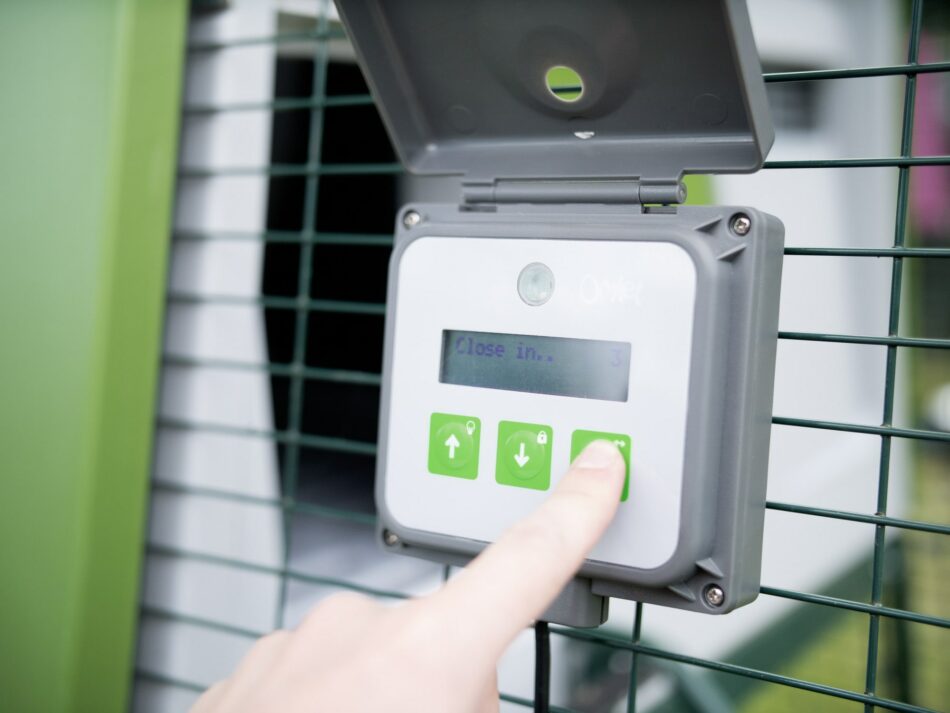

This entry was posted in Uncategorised

Some pets, including rabbits and guinea pigs, are naturally vegan. Hamsters and gerbils, although omnivorous, can thrive on a vegan diet in which the protein content is supplied by plants and vegetables. Others, including omnivorous dogs and out-and-out carnivore cats, cannot be easily pleased on meat-free diets.
All animals need to have their nutritional needs satisfied. But this does not mean you can’t have a vegan dog. Vegan cats, though, are a lot trickier.
Can my dog have a vegan diet?
 If you were to meet a species of animal for the first time and had to make an accurate guess about its diet, you would get lots of clues by looking at its teeth. The teeth of a dog, like the teeth of a bear, proclaim loud and clear that this animal is an omnivore – that is, one that eats both meat and vegetables. If you think of your dog as a domesticated wolf, you get a good idea of its natural diet.
If you were to meet a species of animal for the first time and had to make an accurate guess about its diet, you would get lots of clues by looking at its teeth. The teeth of a dog, like the teeth of a bear, proclaim loud and clear that this animal is an omnivore – that is, one that eats both meat and vegetables. If you think of your dog as a domesticated wolf, you get a good idea of its natural diet.
However, as the panda proves, a supposed meat-eater can sometimes get by perfectly well on a vegan diet. A panda’s teeth are similar to any other bear’s – long canines for meat-eating and molars for grinding vegetation. And yet pandas don’t eat anything other than bamboo. So, if a bear can be vegan, does that mean you can have a vegan dog?
The answer is yes – but it’s a yes with lots of small print! A dog requires a diet that contains the fats and proteins it would get from meat. It is dangerous to ignore this basic need and simply feed your pet with whatever you please. Some dogs have delicate stomachs at the best of times, and a low-fat, high-fibre diet can cause potentially life-threatening problems. A diet that excludes meat should never be fed to a dog without the advice of a professional pet dietician.
The collagen, elastin and keratin found in meat diets are not easily replaced by vegi equivalents. Your dog will also need the ‘long chain’ omega-3 fats found in animal products such as egg, fish and some meats. Vegan omega-3 fats are not the same as animal-derived ones.
All of which presents a headache for the vegan dog owner. There are, however, products available that claim to let your dog live a healthy, meat-free life. Before you take the plunge, it is essential to seek professional, scientific advice and guidance. Compromise is usually the best choice here – a vegan diet supplemented by some of the animal-derived essentials. Crickets, for example, can provide lots of the amino acids and keratin a vegan diet lacks, and they’re 65% protein.
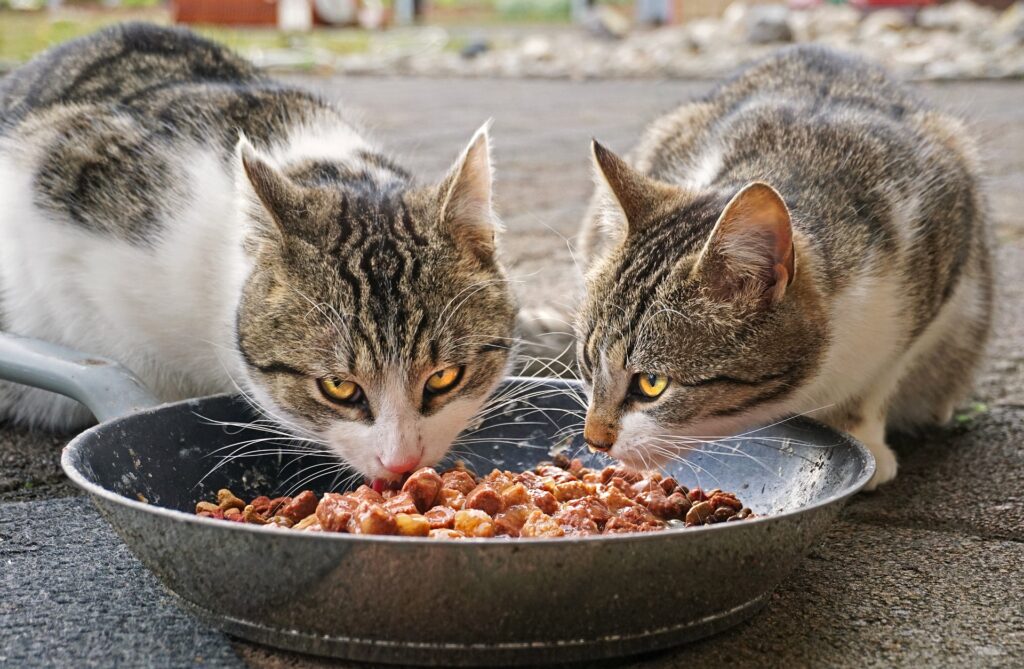
Can my cat have a vegan diet?
The compromise approach is even more important for cats. These are amongst the planet’s true carnivores, obtaining all their dietary requirements from other animals.
The main challenge with minimising the meat in a cat’s diet is that, unlike many mammals (including dogs), cats cannot produce certain proteins. They have to absorb these from the meat and fish in their diet. Amino acids are another issue – cats deficient in the animal-derived amino acid taurine, for example, usually succumb to a specific type of heart problem.
Even a fortified vegan cat food cannot be confidently recommended. Turn the situation on its head, and try to imagine weaning a rabbit onto a meat-only diet, and you get some idea of the challenge – and the ethics – involved.
There are some lab-grown ‘meat’ products in development, with vegan and vegetarian cat owners in mind. However, whether these will arrive – and remain – on the market any time soon is hard to guess.
For many vegan pet owners, there is a huge ethical issue involved in feeding the animals they share a space with. Ethics, however, include the animal’s needs too, and it’s an almost impossible issue to resolve when it comes to cats. If you are able to reduce but not eliminate the meat in your cat’s diet, that’s the safer option.
Top 10 pets for vegan households
There are, of course, plenty of other pets that don’t eat meat, or that eat some meat but can still thrive on a meat-free diet. Here are our ten favourites.
 1. Rabbits. No problems here – rabbits are happy vegans, with diets based on hay and vegetables. You could argue that the soft pellets they eject and then eat are animal products of a sort, but they are simply semi-digested vegetation.
1. Rabbits. No problems here – rabbits are happy vegans, with diets based on hay and vegetables. You could argue that the soft pellets they eject and then eat are animal products of a sort, but they are simply semi-digested vegetation.
2. Guinea pigs. Like rabbits, these wonderful little characters thrive on a 100% vegan diet.
3. Hamsters. As most hamster owners feed their pets with shop-bought hamster food, they may not be able to say exactly what the ingredients of that food are. However, vegetarian and vegan hamster foods are readily available.
4. Gerbils. Like hamsters, gerbils are omnivores that can live happily on a vegan diet. They tend to have rather delicate stomachs, so feeding them with a high-quality pellet mix is essential. Too much fresh stuff can cause problems.
5. Mice. Although they will eat pretty much anything in the wild, mice can thrive on vegan diets; but it is still best to use a food mix prepared specifically for them. This ensures that they will not be deficient in any of the vitamins and minerals they need.

6. Rats. These are the most omnivorous of rodents, but as long as you feed them a vegan mix that has been fortified with all the nutrients they need, they will thrive. Indeed, rats who eat too much animal fat tend to become fat and die prematurely.
7. Chickens. If you watch a free-range hen, it soon becomes clear that she will eat anything – grass, beetles, worms, and everything in your veg patch if you’re not careful! Most chicken feed emulates this mix of plant and animal products. However, it is possible to buy vegan chicken feed, and circumstantial evidence suggests that hens can thrive on it. However, they are likely to produce fewer eggs, and you will not be able to stop them scratching for worms and bugs, no matter how vegan the layers pellets are!
8. Budgies and parrots. Vegans will have no obstacles to face with budgies and parrots, unless the birds are being bred. Egg-brooding female birds need a protein boost, normally delivered via an egg-based food or cooked meat. Vegan alternatives are available, though.
9. Finches. Many finch species enjoy bugs and mealworms as treats, but these are not an essential part of an adult finch’s diet. These birds thrive on a mixture of seeds and fresh vegetables.
10. One for reptile fans. When you think of pet snakes and lizards, you probably have an image of dead mice or doomed crickets. However, there are a few commonly kept pet reptiles that eat a 100% vegan diet, the most popular being the Green iguana. Getting the balance of vegetables just right is very important for the animal’s health, but meat is certainly something you won’t have to worry about.
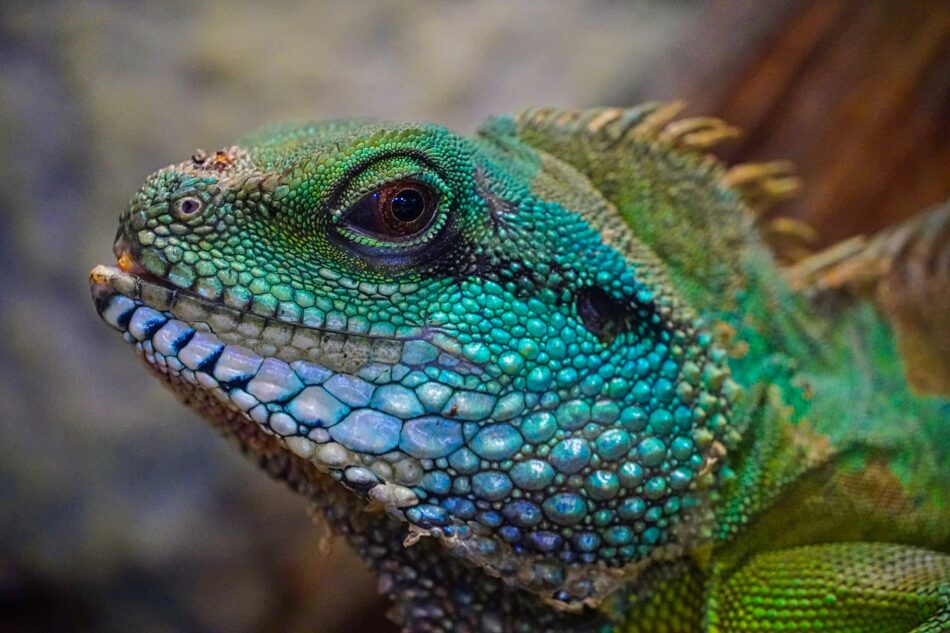
There is no shortage of choice when it comes to vegan pets. Keeping a vegan cat or dog is a much trickier proposition, though. And with all these animals, a balanced diet that matches the pet’s nutritional requirements should be your primary goal.
This entry was posted in Budgies

This article is a part of our Pride of Omlet series, a collection of amazing stories which shine the spotlight on extraordinary pets and share their selflessness, bravery, talent and compassion with the world.
-Written by Anneliese Paul

Buster was destined to chase balls on the beaches of Barry Island. He’s a lovable labradoodle with big brown eyes and a long beard. A thinker with a playful nature, he’s co-authored a children’s book with his human Natalie to bring Autism Awareness to all.
 Ethan, Natalie’s son, was diagnosed with Autism and ADHD aged four. Natalie gave up her job as a teacher to become Ethan’s full-time carer. She always had dogs as a child and, naturally, wanted Ethan to experience the same positive companionship. They went to a local farm and had the pick of three puppies. One was fast and furious, one was quiet and sleepy, and one was in-between. They picked the inbetweener and called him Buster.
Ethan, Natalie’s son, was diagnosed with Autism and ADHD aged four. Natalie gave up her job as a teacher to become Ethan’s full-time carer. She always had dogs as a child and, naturally, wanted Ethan to experience the same positive companionship. They went to a local farm and had the pick of three puppies. One was fast and furious, one was quiet and sleepy, and one was in-between. They picked the inbetweener and called him Buster.
After a few weeks at home, it was clear that Ethan wasn’t taking to Buster. He just wasn’t interested in him. So he became Natalie’s companion instead, being a full-time carer isn’t easy and Buster’s a great source of comfort on difficult days. He motivates Natalie to keep going and gives her much-needed respite, with long walks on the beach.
A couple of years after Ethan’s diagnosis, baby Isobelle was born. Isobelle’s afraid of the dark, so Buster sleeps in her room and helps her feel safe. And in the daytime, Buster is Isobelle’s playmate. They love playing dress-up together, and at the end of the day, she’ll read him a story and brush his hair.
As Buster grew, the hair on his chin got longer and longer and longer! Until he developed a fully grown, 7-inch beard. It’s not a thing you see every day, a dog with a beard. People started staring. Natalie’s used to people staring, sadly many people don’t understand Autism, and when Ethan has meltdowns, Natalie and her family have experienced staring and unkind remarks, which have been devastating.
She realised that staring at Buster was something different. When walking on the beach, Natalie was approached by people asking, “Is it real? Have you stuck it on?!” It was curious and fun and got people talking in a good way. So what does a positive ex-primary school teacher do with that? She writes a children’s book, of course! Natalie wrote a story starring Buster called ‘That Dog Has Got a Beard’.
It’s a story about being special and unique. Natalie and Buster have toured schools and libraries all over Wales and even appeared on ITV Wales, opening conversations that celebrate differences and spreading Autism Awareness through the story of Buster’s Beard.
“A lot of children don’t see disabled children, and there’s a lot of negativity around it. You want people to be accepting, and a lovable labradoodle is an excellent way to open a conversation. He looks different. He’s got a beard. But that’s wonderful, you know? “

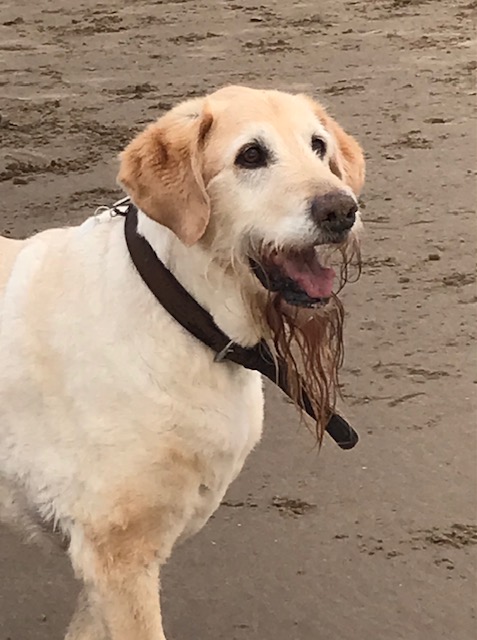
This entry was posted in Dogs
Whether you’re a new cat owner or a long time litter user, the world of cat litter can be confusing and selecting the right litter to suit your needs and your cat’s preferences isn’t always an easy task.
Kittens are adorable, playful balls of fluff but they’ll also start producing 1s and 2s from the get go, so you need to get your potty training sorted from the start. But with a range of litter materials from wood to paper, clay to silica and even tofu on offer, which is going to be best now and when they are a bit older?
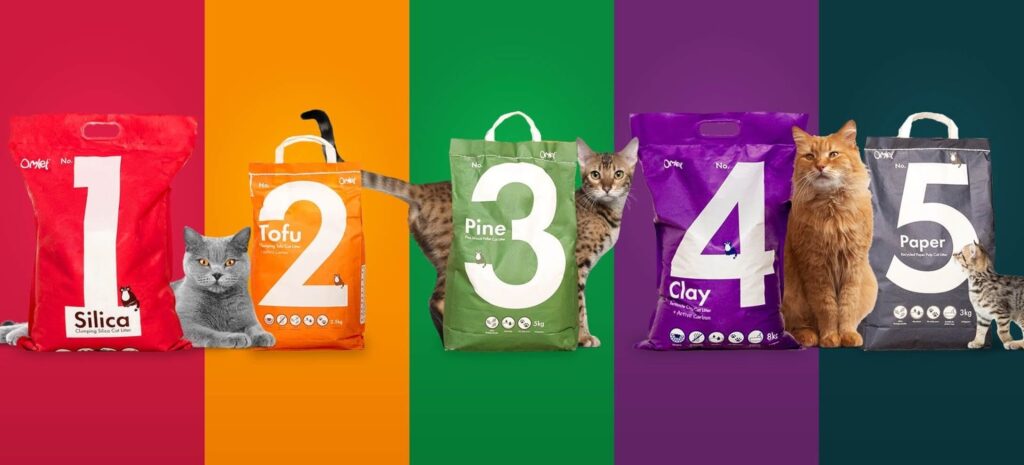
With so many types of litter on offer, it’s no surprise that in a study of cat owners, we discovered that a massive 93% of them have tried different types of cat litter before their current choice. Does this sound like you?
In the survey, we discovered 54% of the respondents reported that they think their cats might be fussy about the litter they put down for them. As well as feline fussiness, cat owners are also disappointed with litters they are trialing and as a result have to spend more time and money on finding the perfect match for them and their cat.
Now, to tackle this difficult decision, we are launching a collection of 5 easy to understand, high performance cat litters. Simply named 1, 2, 3, 4,5, the colourful collection offers 5 proven materials for you to choose from: Silica, Tofu, Pine, Clay and Paper. But don’t worry about figuring out the differences to make your choice, this handy Cat Litter Generator will deliver two expert recommendations for you to narrow down the decision making process.
Omlet’s Head of Marketing, Johannes Paul, says: At Omlet, we’re striving to make choosing cat litter as easy as 1, 2, 3! This new collection really takes the guesswork out of a major choice for so many cat owners, and we hope it will save our customers from lots of disappointment and wasted time.

Learn more about the cat litters in the Omlet collection…
Ultra Hygienic & Absorbent
No. 1 Silica Cat Litter is made from small sand particles that are extremely absorbent to reduce moisture and odour, keeping it fresh and hygienic for longer. Not only do these small grains absorb and dry faster than other litters, their fine nature also means the litter doesn’t stick to paws and get tracked around your home. The clumping cat litter is also easy to spot clean to improve longevity.
Clumping & Compostable
No. 2 Tofu Cat Litter is made from crushed tofu, and is very effective at neutralising odours thanks to an active carbon composition that traps bad smells. The clumping cat litter is also highly absorbent, reducing waste and keeping the litter tray fresher for longer! Crushed tofu is biodegradable and can be composted, for easy and planet friendly disposal.
Fresh Scent & 100% Biodegradable
No. 3 Pine Cat Litter will transform the litter tray with the sweet scent of fresh wood, plus it’s 100% biodegradable and compostable, making it a friendly option for both your cat and the environment! The large wood pellets are highly absorbent, offering long lasting freshness with outstanding odour control, and also minimising waste and cleaning time.
Long Lasting & Low Waste
No. 4 Clay Cat Litter is made of highly absorbent bentonite clay balls with active carbon particles for extreme odour control. The supreme power of this clumping cat litter makes spot cleaning after use extremely quick and easy. This not only improves the general hygiene and freshness of cat litter trays, but also minimises wastage and improves longevity.
Non-Clumping & Perfect for Kittens
No. 5 Paper Cat Litter is made from recycled newspaper pellets with natural odour and moisture absorbing properties. Not only is paper environmentally friendly and biodegradable, it also stays fresher for longer and minimises wastage. The lightweight bag is super easy to handle, and it’s non-clumping nature makes it a perfect option for younger cats, as it’s softer on paws and safer on tummies.
Omlet Cat Litter is now available exclusively from Omlet.co.uk, priced between £13.49 and £14.99 with FREE delivery.
Video here:
This entry was posted in Cats
Dogtor Adem, founder and owner of Dog-Ease, is a dog behaviourist and trainer with over 15 years experience working with dog owners and their canine best friends. In this blog post, Adem provides us with helpful tips on preventing dog theft, and what to do if you experience dog theft yourself.

With dog theft on the rise, it’s only natural that we might feel worried about taking our furry family members out and about at the moment. I think most of us can agree that if anything should happen to them, we would feel devastated. So, I have put together my top tips for keeping your dog safe from theft when both at home and out and about. Following on from this, I’ve also put together some tips on what to do should you find yourself in the awful position of your dog having been stolen. I hope you never have to refer to them, but they might just help you be reunited should you find yourself in this unfortunate position.
MY TOP TIPS FOR PREVENTING YOUR DOG THEFT
START AT HOME
By this I mean you should review your current security measures at home. Start by ensuring gates and fences are secure and avoid leaving your dog in the garden unattended. You may also want to ensure your dog cannot be seen by people passing by when you are out of the home. You can do this by making them a base in a room away from any windows that can be easily looked into or even by closing the curtains on these windows when you are out.
MAKE SURE YOUR DOG IS MICROCHIPPED
It is not only law to have your dog microchipped, but it is also best practice. If your dog is ever separated from you a simple scan of their chip in their neck area should reunite you pretty quickly. Keep your dog’s microchip details up to date. It’s usually really easy to do this over the phone or online.
ADD AN ID TAG TO YOUR DOG’S COLLAR AND CONSIDER A GPS TAG ALSO
By law, your dog should have an identification tag attached to their collar when outside of your home. This makes it really easy for you both to be reunited without needing your dog’s microchip to be scanned. You could also consider attaching a trackable GPS tag to your dog’s collar. There are many on the market to choose from and these can be purchased online, if not from your local pet shop. Some also have fun features to use on a daily basis such as tracking your dog’s activity levels.
TEACH YOUR DOG THE RECALL COMMAND
Teach your dog the recall command and make coming back to you a fun game that you can play throughout your walks together. Offer a tasty treat or engagement in a game such as fetch each time they return to you. This makes them more likely to want to return to you, seeing the recall as a fun part of your walk. Head over to the Blog page of my website www.dog-ease.co.uk/blog/ to watch a tutorial on how to begin this training if you haven’t already had a chance to.
KEEP YOUR DOG’S ATTENTION
Make it fun for your dog to stay close to you on your walk if you are letting them off lead. For example, you could practise off lead heel work as you walk, offering a tasty treat as a reward for their focus, or play recall games. Taking a special toy such as a ball can also help to keep your dog’s attention and focus with them chasing and retrieving during your walk.
KEEP YOUR DOG IN SIGHT
Following on from keeping your dog’s attention, avoid letting your dog go out of your sight on a walk or leaving them unattended outside a shop, school, or even in your car. The less opportunity for them to come into contact with strangers without you also present, the better.

WALK WITH OTHERS
If possible, walk with a family member or socially distanced with a friend. You could also try to walk in public areas where other people are walking and present too. Pick times of the day where other people are likely to be around and walk in daylight if possible. If this is not possible, try to walk in well-lit areas. Safety is often found in numbers and the more people that are around the less likely you may be to be targeted.
CONSIDER TAKING ANTI THEFT DEVICES WITH YOU
Consider taking an anti-theft alarm or another similar device on your walk with you, even a whistle is better than nothing to be able to attract attention with. You could also try to keep your mobile phone handy to use if necessary, although it’s best to not allow your mobile phone to distract you from what is going on around you as you walk. See the next tip!
STAY ALERT
Following on from the tip above, stay alert and be vigilant on your walks. Watch out for any unusual activity or people in the areas you might typically walk. It is best to limit your use of any electronic devices such as your mobile, even to listen to music. The more aware of your surroundings you are, the more likely you will be to spot anything not quite right.
AVOID CLOSE CONTACT WITH STRANGERS
Avoid letting people you don’t know pet your dog or telling people you don’t know any details about you and your dog. It’s nice to be friendly but be vigilant about the information you share.
BE LESS PREDICTABLE
If you’re particularly concerned, change up your routine frequently. This makes it harder for anyone ‘watching and waiting’ to predict and plan to ‘bump into you’ on a walk.
PREP OTHERS WHO ARE RESPONSIBLE FOR WALKING YOUR DOG
If you use a dog walker, ensure you ask them what steps they are taking to avoid your dog from being stolen. You can also ask that they remain vigilant in securing your property when returning your dog to your home and ask that they look out for and alert you to any unusual activity.
USE SOCIAL MEDIA AND LOCAL NEWS TO YOUR ADVANTAGE
Check local social media pages and local news for up-to-date information on what is going on in your area. Often any worrying incidents are reported by residents with details of suspicious people and even sometimes vehicles too look out for.
BE MINDFUL OF WHAT YOU SHARE ONLINE
Sharing your location and details of your pet on non-private forums such as on non-private social media pages can alert potential thieves to your where abouts. Make sure you are mindful of what you share and where you ‘check in’, with or without your dog.
WHAT SHOULD YOU DO IF YOUR DOG IS STOLEN?
In the awful event that your dog is stolen, here are some tips to help you find and be reunited with them.
REPORT THE THEFT IMMEDIATELY
Report the theft immediately to the police and ensure it is recorded as a crime rather than as a lost pet. You should receive a crime reference number for your records.
CHECK CCTV
Check all available CCTV footage in the area your dog was stolen from to gain evidence of any people needing to be identified or vehicles that may have been involved. You might also want to check in with neighbours and those in the local area to see if anyone has any footage from their own security systems – from Ring Doorbell footage to Dash Cam footage. Anything is worth a shot and could lead to identifying something or someone.
CONTACT YOUR MICROCHIP COMPANY
Contact the company your dog’s microchip is recorded with and register your dog as stolen. If your dog is scanned by a vet elsewhere, they should then be alerted to this and your dog returned to you.
CONTACT LOCAL VETS
Contact all vets in the local area to let them know of the theft. Provide a photo of your dog if possible and include details of any markings or particular features that they have so they can identify them more easily.
MAKE THE PUBLIC AWARE
Make other people aware of the theft by putting up posters stating your dog has been stolen, with your contact details on them. You should also post a copy of such posters, or an equivalent, on social media sites. If you ensure that the settings of your post are set to ‘public’ you can ask others to share your post and reach a much wider community. The further your dog’s details are shared, the more chance you have of your dog being identified and returned to you!
DON’T GIVE UP
Don’t give up hope! Keep sharing your dog’s details far and wide. Someone somewhere might know something and help you to be reunited.
I hope you found the above tips useful. Stay alert and keep safe!
Dogtor™ Adem
Owner of Dog-ease Training & Behaviour
www.dog-ease.co.uk
This entry was posted in Dogs
There are several causes of feather loss. Hens usually go through a moult in the Autumn, usually around October or November. The first year tends to be a small moult affecting the head and neck area but the second year is a little more drastic. Hybrids moult more than pure breeds and often look ready plucked. The whole process takes around 3-4 weeks to be completed and starts at the neck, moves along the back, breast and ends at the tail. It happens annually to replace old worn out feathers. Sometimes dramatic total body moults occur where nearly all the feathers fall out overnight but they do grow back. You should start to see and feel little quills poking through the flesh which grow and open out into lovely new feathers which will keep her warm and dry throughout the winter. Make sure you provide a good quality layers meal for them because the moult takes a lot out of your hens. Don’t give too many treats as these don’t really provide enough nutritional value but wheat is very good as a scatter feed in the afternoons or you could perhaps give a wheatgerm porridge made with warm water to keep their little bodies warm overnight. Adding Poultry Spice to their layers meal or a Chicken Tonic to their water will help correct any mineral imbalance caused by losing and growing new feathers as they contain lots of minerals and will help the hens over the moulting process. Adding protein to the diet can also help so things like hard boiled eggs, tuna canned in spring water rather than brine which is too salty or live mealworms are good, protein rich foods. Egg production often takes a break during the moult as so much energy is put into growing the new feathers but once they are fully feathered again, the eggs should return.
Another cause of feather loss is feather pulling by another hen. The neck and back area tends to be a prime target, as is the vent area. You can get sprays to use on the bullied bird which make her feathers taste unpleasant to the other birds and this usually deters pecking. If the skin is red, sore or broken, separate the injured hen straight away and you can use Veterinary Wound Powder on her to help stem the bleeding and promote healing. Hens are morbidly attracted to the colour red and will peck at wounds until they are in a dreadful state if nothing is done so Gentian or Purple Spray is very effective as it stains the skin purple and this makes it a much less obvious target for the bully. You can also use Stockholm Tar which acts like a sticky black plaster, deterring further pecking whilst allowing the wound to heal underneath. With my own hens, I’ve found that some of these sprays cause the feathers to clump together though and this can make them more of a target for a bully so a puff of Veterinary Wound Powder or even household cornflour in an emergency disguises the sore area effectively and helps stop bleeding. If any hen develops a wound of any kind, remove them and allow it to heal for a few days before reintroducing them to prevent the wound being pecked.
A broody hen will pluck the feathers from her breast and abdomen to line the nest to help protect her eggs so if she’s displaying any odd behaviour or is clamped to the nest all day, this may be the cause. However, there is also a slight possibility that she might be allergic to any nesting material you are using. Some hens seem to have skin problems when they are in contact with shredded paper or some of the hemp based bedding. If you are using any of these, it might be worth taking them out and replacing them with something like wood shavings which are sold as rabbit/guinea pig bedding as these tend to be non-allergic. Sudocrem sold for nappy rash in babies is very soothing for sore skin in hens too so it might be an idea to try gently rubbing some onto the bald, red areas to see if this helps soothe any irritation.
There could also be another reason for baldness and that is skin parasites. Dirty vent feathers, lots of scratching and dustbathing, hunched or withdrawn hens and soft shelled eggs are often indications that your hen has an infestation too. Mites can’t be seen easily with the naked eye but they leave the skin looking sore, red and featherless. Lice can be spotted quite easily. The hot spots where lice tend to hide are around the vent, under the wings, round the abdomen and chest and the neck area. Ruffle the feathers against the direction of growth and look for little scuttling creatures or tiny cream eggs stuck to the feather shafts. If you come across any, you can get louse/mite powders from various sources including poultry feed suppliers/farm suppliers and some large petshops. Apply it to all your hens and repeat the treatment after a week to catch any eggs which might have hatched out. Depluming mites don’t respond to some of the mite powders on the market so if there’s no improvement, try one which has Pyrethrum or Permethrin in as these are very effective against this particular mite.
Red Mite don’t live on the hens but live inside the hen house and move onto the hens during the night so if you check in all the corners, pull out roosting bars if you can, check around the roof for signs of infestation. They aren’t particularly easy to spot as they are only about 1mm long and are grey before feeding and red after due to the blood that they suck from the hens and this blood sucking can lead to anaemia and lethargy. If you have a red mite infestation in your chicken coop, you may see tiny blood spots on the hens eggs and there may also be a greyish powder which can be seen around the ends of the perches. If you wipe the undersides of the perches with a clean white paper towel and find red streaks on it, this will show that there are red mite in the coop. Spreading Vaseline or nappy cream on the ends of the roosting bars and in the ledges where these bars sit can trap red mite too as they head for dark crevices during the day and any which do become stuck in the sticky cream can be wiped or washed off. To treat an infestation, you will need to remove everything from the coop which can be taken out and spray with a proprietary red mite treatment. Steam cleaners are also very effective for eradicating lice and mites from coops.
This entry was posted in Uncategorised
You can usually tell if a hen is broody or not fairly easily. If she goes into the nest and doesn’t come back out again and starts making a very strange noise whilst puffing herself up like a football she could be broody. The noise they make is obviously different from the usual range of sounds and can vary from something like a very deep cluck-cluck-cluck rather like horses walking on cobbles to an ear splitting screech! Another sign of broodiness is feather pulling and you may notice that your hen starts plucking them from her breast to line the nest ready for the eggs resulting in an embarrassing bald patch on her belly. You may also spot a strange habit of picking up leaves, twigs, feathers and bits of grass and throwing them over her shoulders in an attempt to make her nest! A normally placid hen can turn aggressive and will peck you if you try to move her and the opposite can happen to a very flighty bird who will suddenly let you cuddle her till the cows come home as soon as she turns broody!
If you act quickly, you can get her to resume egg laying much sooner so try to restrict her access to the nest if possible, although this is usually very difficult if you have other hens who are trying to lay. If she sleeps in the nest, you need to encourage her to sleep on the roosting bars to allow lots of nice fresh air to circulate around her to keep her cool as she’ll get wonderfully warm and cosy overnight and that will just prolong the broodiness. If you put a brick, upturned plant pot, football or even a garden ornament into the nest, this will stop her from roosting in it but remember to remove it during the day so that your other hens can lay eggs. Keep her out of the nest if you can during the daytime. If you spot her in the garden sitting on a nest she’s made from leaves, twigs and feathers, make sure this is quickly removed and move her on or tempt her away with a treat or two.
The urge to go broody is usually caused by a rise in internal body temperature so a quick cold bath usually brings her back to normal and should stop the urge. Dunk the hen’s rear end and abdomen in a bucket of cold water until feathers are soaked. You can do this several times a day. Continue soaking until she stops being broody which should only take a couple of days depending on how long she’s been broody for. It sounds horribly cruel but they actually seem to find it soothing as they are so hot, bothered and cross that a cool bath makes them feel a lot more comfortable. Some people use an old towel to wrap an ice block or fill a plastic bag with ice cubes and put that under the hen in the nest and the coldness soon drives them from the nest. If your hens are in a run and she is determined to sit on the eggs at every possible opportunity, a trick we have used on our own hens might work for her too. We sectioned off the end of the run for our broody hen and put food and water in it. We popped her in there as soon as they woke up in the morning and kept her there until our other hens had laid. As soon as they all had, we removed the barrier, closed the coop door and let her socialise with the others. It took about a week of isolating her out of the way of the nest to break the broodiness but it worked and she’s been fine since. If your hens are free ranging, it’s even easier. You can make a separate run for her using some fruit cage netting or chicken fencing and leave her in there with food and water until the others have laid then you can let her out to join them.
You can let her sit it out if you like as it won’t do her any harm but you won’t get any eggs until she stops being broody and if she’s been sitting for a long time, this could mean no eggs for weeks afterwards. If she does stay put in the nest, try to encourage her to get up once a day to eat, drink and go to the toilet. Broody hens can lose a lot of body weight while they are sitting. It’s important that you check her regularly for lice and mites as they tend to infest broody hens because they aren’t dustbathing and preening as regularly as they normally would. A bad infestation of red mite can kill a broody so it’s also vital to check the coop carefully too as these mites live in crevices and corners of the coop rather than on the bird itself. If you happen to find anything on her, a dusting with a suitable powder or spray, repeated a week later, should remove any stowaways and there are various red mite treatments available for treating the coop. Once she’s lost the urge to sit, she’ll come off the nest and start socialising again and hopefully the eggs should start to arrive again.
A sick hen may also give a false impression that they are broody so be aware that she may not be feeling hormonal at all. A sick chicken will look completely miserable – head tucked into its neck, eyes closed, hunched up shoulders and a droopy tail. They withdraw themselves from the other hens and look unhappy and listless. A hen in lay or even a broody hen should have a bright red comb while a sick hen’s is yellowish and droopy. If you are concerned that she may be ill, it might be a good idea to take her to see a vet to get her checked over properly.
This entry was posted in Uncategorised
Both the Eglu Go and Eglu Classic houses sleep up to 4 medium to large chickens, however the standard 2 metre run that come with them, are really only suitable for up to 2 chickens, as it is best to try and give each chicken about a metre of run each.
You can extend both the runs, 1 metre at a time, to make them longer which in turn allows you to keep up to 4 chickens… (If you want three chickens, purchase the standard Eglu with a 1 meter run extension, the chickens will be quite happy in a run this size)
The Eglu Go UP can sleep up to 4 medium to large chickens, but again the standard 2 metre run for the Eglu Go UP would only be suitable for 2 chickens. You can also extend the Eglu Go UP run by adding 1metre extensions.
With regards to the Eglu Cube, the house itself will sleep up to 10 small chickens, but with the standard 2 metre run, we would suggest between 4 and 6 chickens, 4 chickens if you were NOT going to let them free range and 6 chickens if you were. The Eglu Cube run extension can also be extended 1 metre at a time, and you can have as many 1 metre extensions as you require.
If you were to have an extension on the Eglu Cube run making it 3 metres long, we suggest the number of chickens be between 6 and 10 chickens, 6 chickens if you were NOT going to let them free range and 10 if you were.
This entry was posted in Uncategorised
How do I get my chickens to use The Chicken Swing?
Chickens being birds are a bit quirky. Nonetheless, they are extremely habitual and love a routine. It seems the older they get, the slower they are to take on new habits. They are pretty low on the food chain which makes it nice for us because their production rate is high – lots of eggs! However, this makes them cautious and wary of new things. It also makes them group or flock up. They prefer another bird to try new things first. They also remember things surprisingly well. Do you know they will always remember and bond with their hatch mates? They also remember things that scare them and things that reward them with food or pleasure. There are also basic instincts I call “Chicken Things”. One of them is roosting up high in trees. If they perch on moving narrow branches a lot of predators are unable to get them. A moving perch is natural to them.
So, with all that being said, how do we get chickens to get on The Chicken Swing?
Place the swing above the heads of the other fowl in your coop, if you can. You don’t want the swing spooking or hitting other birds (the light – weight design and smooth edges will not injure them.) They are quite able to jump up to four feet or more. A good starting point for full grown/ teenage chickens is twenty inches, or about your knee – height. If you have a small coop and cannot raise the swing that much, don’t worry. Swinging birds will not be able to get the big swing gliding motion or as hard of a kick off as with a full – height set up. But, they will still enjoy the gentler swinging movement of a smaller backyard coop set up. Other fowl will learn to stay clear. They tend to naturally stay out of the way of its movement.
Place The Chicken Swing™ free of obstructions as it swings. For a full swing installation, try to keep it about 18 – 24” away from walls or objects in the swing plane. Smaller coop set – ups have less swing so you can get away with having closer objects. Once they trust the swing, chickens grow more tolerant of kickoffs banging against the coop. (I think that is the goal for some of my hens.) If you have more than one Swing, be sure they can’t collide.
If you have a trusting hen, you can try placing her up on the swing and immediately rewarding her with meal worm treats. Once she is used to that, gently give the swing a pull to get it swinging. Give her a treat eachtime it swings toward you. Soon she will jump up on the swing and start swinging when she hears the bag shake. However, if you try to force her, this method can backfire on you. If the hen gets scared or feels forced, she will relate this to the swing and the other hens might follow her lead of fear. This will set you back. I recommend you do not try this with all your flock, but choose only a few, be very gentle, remain calm, and have rewards ready. Of my 30 hens, only 4 or 5 were taught using treats. Generally, if you get one swinging others will give it a try. I note that in my flock, hens that use the swing most often are not necessarily those trained using treats. Chickens tend to choose their own time. Some are very habitual while others are whimsical. Some are morning swingers. Some swing after their daily egg. Some hop on at odd times. Chickens are chickens, I guess.
One other thing you can use is youth. Young chickens have a lot more free time and are more willing to take risks. Introduce the Swing soon after bringing them home, or at least before they start laying. Not only is it an irresistible adventure for them, it is just too dang cute to watch them carry on and practice moves. I have had older chickens take up swinging. But results are quicker with younger fowl.
Start your chicks out swinging
Whether your chicks are bought from a hatchery or hatched in your coop, chicks will take naturally to The Chicken Swing™ in most cases. The design of our swing allows for chicks just days old to hop up and start trying it out. Its design is lightweight and will not injure them if they are bumped when a hatch mate or fowl of similar size is using it. You may set it up right in your brooder by using the “small coop installation” procedure. Hang the swing from the cross-member using some extra S-Hooks, or by re threading the rope. You can also use a broom stick or shower rod on top of your brooder box and install it similar to full swing method. Just lower the Cross-Member support knot (or untie it) and let the Cross-Member rest on the Side Tie Knot.
For the first few days, set the swing height about two inches above the floor. You may gently place the chick on the swing perch. If they jump off right away, that is just fine. Don’t try to force a chicken to swing. They will get on by themselves after your initial placement if you have been gentle. (No treat is needed with very young chicks.)
After they all seem to have gotten comfortable jumping up on it in this low stage, begin raising it bit by bit as they grow. It is amazing how high those little fluffs can jump! If you have different – sized chicks, you may set a stump or something similar under one side of the swing to help the smaller ones get on. Be prepared to spend way too much time watching them play!
A final point: my flock gets excited when they hear me coming. They stop doing whatever they were doing anticipating garden scraps or treats. This makes it hard to get photos of them swinging. I see them swinging the most when I look out the window out of sight. I had to stop fussing over them every time I went out there so they would just keep swinging when I wanted to take a picture or show them off to a friend. And remember peafowl and turkeys also enjoy The Chicken Swing™!
Fowl Play Products® hopes this information helps to get your backyard flock swinging. If you have older fowl, it might be tricky and take some time to get it going. The saying “Can’t teach an old dog new tricks” is sometimes true. In the end it is up to individual chickens. Not all fowl like to Swing, but we found a whole lot of them do. If you are unable to get your older Chickens to take up swinging, you may want to get a few chicks and introduce The Chicken Swing™ to them. Their example might set the mood for other fowl in your coop.
This entry was posted in Chickens
You can easily return an unwanted item to Omlet Ltd.
Please use the link below to the Royal Mail website, where you can easily create a free returns label. This can be attached to your returning parcel, taken to the post office who will return it to Omlet for free.
If you have any questions about our returns policy, then please don’t hesitate to call our customer services team on 001295 750094, Monday-Friday between 9:00am and 5:30pm.
Also if it is a large product you would like to return, then please contact customer services, who can arrange a free courier collection service for your items.
https://www.royalmail.com/track-my-return/create/110
This entry was posted in Uncategorised
You can easily return an unwanted item to Omlet Ltd.
Please use the link below to the Royal Mail website, where you can easily create a free returns label. This can be attached to your returning parcel, taken to the post office who will return it to Omlet for free.
If you have any questions about our returns policy, then please don’t hesitate to call our customer services team on 001295 750094, Monday-Friday between 9:00am and 5:30pm.
Also if it is a large product you would like to return, then please contact customer services, who can arrange a free courier collection service for your items.
https://www.royalmail.com/track-my-return/create/110
This entry was posted in Uncategorised
The Run Door Self Fit Kit lets you add an extra access door to your Eglu run or Walk in Run. Simply cut out a section of your run mesh, cover the edges with the supplied edge protectors and clip the door in place.(You will need some good quality pliers to cut the hole in your run panel.) If your pets move their toys to awkward parts of the run or occasionally lay an egg just out of reach, the Self Fit Door Kit is just the thing for you!
Note: The door opens inwards not outwards, so remember to take that into account when deciding on the location of your new door. If you are using it on an Eglu Go run or an Eglu Cube run, the angle of the Run panels will mean you need to mount it slightly higher to avoid it colliding with the ground when you open it.
830.0556C
This entry was posted in Uncategorised
Chicken Keeping Course Risk Assessment Form
chicken_course_risk_assessment
This entry was posted in Uncategorised
Running your own course is a fulfilling and rewarding way for you to share your hobby. Whether you keep chickens, rabbits, guinea pigs or bees in your eglu you can apply to set up your own course.
By following this like to the Omlet Courses page https://www.omlet.co.uk/courses/courses.php?page=host_your_own you can sign up and start holding your very own hen or bee keeping parties.
This entry was posted in Uncategorised














 If you were to meet a species of animal for the first time and had to make an accurate guess about its diet, you would get lots of clues by looking at its teeth. The teeth of a dog, like the teeth of a bear, proclaim loud and clear that this animal is an omnivore – that is, one that eats both meat and vegetables. If you think of your dog as a domesticated wolf, you get a good idea of its natural diet.
If you were to meet a species of animal for the first time and had to make an accurate guess about its diet, you would get lots of clues by looking at its teeth. The teeth of a dog, like the teeth of a bear, proclaim loud and clear that this animal is an omnivore – that is, one that eats both meat and vegetables. If you think of your dog as a domesticated wolf, you get a good idea of its natural diet.
 1. Rabbits
1. Rabbits



 Ethan, Natalie’s son, was diagnosed with Autism and ADHD aged four. Natalie gave up her job as a teacher to become Ethan’s full-time carer. She always had dogs as a child and, naturally, wanted Ethan to experience the same positive companionship. They went to a local farm and had the pick of three puppies. One was fast and furious, one was quiet and sleepy, and one was in-between. They picked the inbetweener and called him Buster.
Ethan, Natalie’s son, was diagnosed with Autism and ADHD aged four. Natalie gave up her job as a teacher to become Ethan’s full-time carer. She always had dogs as a child and, naturally, wanted Ethan to experience the same positive companionship. They went to a local farm and had the pick of three puppies. One was fast and furious, one was quiet and sleepy, and one was in-between. They picked the inbetweener and called him Buster.




